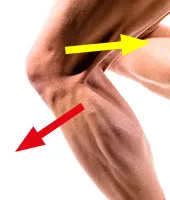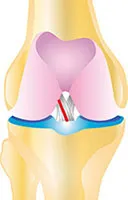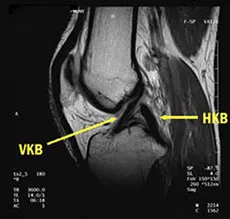
German international Sami Khedira is in top form for the Germany vs. Italy international match. But in the 67th minute, a challenge with Andrea Pirlo leads to a personal catastrophe.function-anterior-cruciate-ligament His right knee joint turns inwards. The 26-year-old immediately grabs his leg and collapses to the ground with a pained expression on his face. It's clear to presenters and viewers that something terrible has happened. A tear in the anterior cruciate ligament is a catastrophe for any athlete. Why is this ligament in the knee joint, which is only about 2.8 cm long, so important and why can injuries to the anterior cruciate ligament mean the end of an athlete's career.
The anterior cruciate ligament is the most important stabilizer in the knee joint. It is located in the center of the knee joint and is primarily responsible for preventing the lower leg from slipping forward relative to the thigh.
What many people don't consider is its function as a sensor. A healthy cruciate ligament contains numerous sensors for measuring tension and pull. This means that the tension in the ligament is constantly being measured, or how strongly it is being pulled. A nerve connection to the spinal cord can then reflexively control the muscles in the leg. Even before I consciously perceive a displacement in the knee joint, the cruciate ligament has already registered the dangerous condition. Via its nerve connection and the reflex circuit with the muscles in the leg, immediate countermeasures are taken, thus preventing anything worse from happening. This is also known as proprioception.
This makes the loss of the cruciate ligament doubly painful. On the one hand, the stabilizing ligament is missing, and on the other, the highly sensitive measuring device with its reflex circuit is also out of action.

The loss of proprioception in a cruciate ligament tear is also what often causes attempts at exclusive muscular stabilization to fail. Of course, a person with a cruciate ligament injury is capable of significantly building up their muscles to achieve improved knee joint stabilization. But without the sensitive cruciate ligament sensor and its reflex circuit via the spinal cord, muscular stabilization can only function to a limited extent. In most cases, there has already been significant displacement of the lower leg relative to the femur in the knee joint before the muscles even react. The knee is further damaged. This makes surgery unavoidable for athletically active individuals. Since suturing the anterior cruciate ligament unfortunately does not work, various techniques for replacing the anterior cruciate ligament have been established. Two different transplants are most commonly used today: the patellar tendon or semitendinosus tendon, together with the gracillis tendon, two tendons from the posterior thigh. Both procedures have their advantages and disadvantages.

Here are a few bare figures on the mechanics of the cruciate ligament and the most common transplants:knee mri A healthy cruciate ligament has a tensile strength of approximately 2160 N. That corresponds to approximately 220 kg. The tensile strength of a patellar tendon transplant is between 2400 and 3600 N, depending on the selected width. The tendons from the posterior thigh are even stronger. A quadruple graft made from the semitendinosus and gracillis tendons has a tensile strength of over 4100 N. That corresponds to more than 410 kg. Since the transplants themselves are all significantly more stable than the natural cruciate ligament to begin with, the weak point of the system is not the transplant, but the attachment of the new ligament to the bone. A variety of different implants are available for this. All of these screws, plates, or pins are intended to hold the tendon in the bone. They do just that, some more than others.
Ultimately, however, there is no other option than to give the transplant sufficient time to properly grow into the bone.
This is where the patellar tendon graft demonstrates perhaps its only real advantage over semitendinosus and gracillis tendon grafts. Due to the bone fragments present in the patellar tendon, it integrates much faster into the bone and is often firmly integrated after just 6-12 weeks.
Let's get back to Sami Khedira. The very next day, the media reported a downtime of approximately six months. Why six months, when such a transplant heals in 12 weeks? The magic word is "ligamentization." When the transplant is removed, all the blood vessels that supplied it are severed. It is taken from the body and implanted in a completely different location. This severing of all the blood vessels always causes a cruciate ligament transplant to initially partially die.
All readers who were pleased in the previous section about the high tensile strength of the transplants compared to a natural cruciate ligament should be aware that the transplant does not remain as stable. Due to partial death, the transplant loses a considerable amount of tensile strength. This can even decrease to the point where the tensile strength of the transplant is temporarily significantly lower than that of a healthy cruciate ligament. Then the process of ligamentization begins. This means that the former tendon is converted into a ligament - the anterior cruciate ligament. First, new blood vessels are formed. Then connective tissue cells, so-called fibroblasts, migrate into the tendon transplant. These fibroblasts then begin a continuous modification of the collagen structure of the transplant. This slow remodeling process, in which the tendon is transformed into a ligament, is also known as remodeling.
In the first six weeks after surgery, there is a significant decrease in tensile strength. Only then does the transplant slowly stabilize and regain strength. Studies have shown that this ligamentization process takes at least a year. There is currently no way to accelerate this process. Even the best physiotherapy, which Sami Khedira will certainly receive, has no influence on the ligament's phased healing behavior. Many experts assume that after about six to eight months, the new ligament will have reached the tensile strength of a healthy cruciate ligament. Unfortunately, there is no guarantee of this. For this reason, all recreational athletes are advised to refrain from all high-risk sports for at least a year after cruciate ligament surgery. However, the pressure on our professional athletes is so immense that they often return to their sport much sooner. Unfortunately, this repeatedly leads to serious setbacks, as the long list of footballers with recurrent cruciate ligament tears demonstrates.
I wish Sami Khedira all the best on his recovery and that he will soon be able to play for the German national team again.








